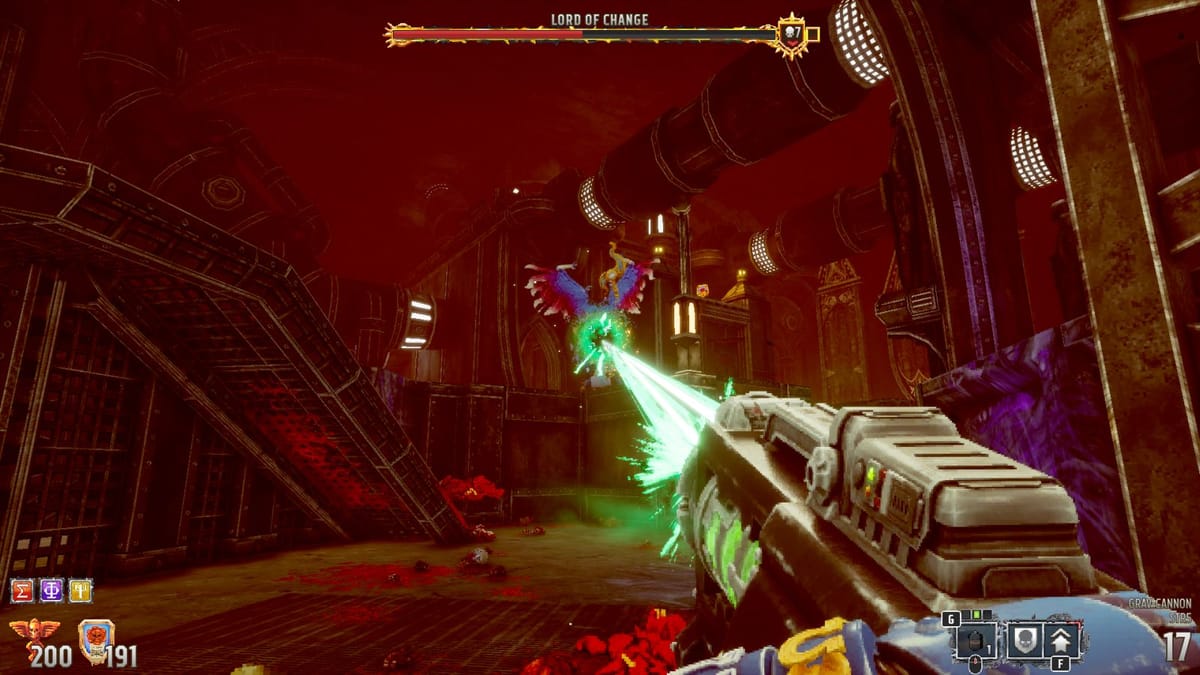
When I think of Warhammer 40K, my mind goes to strategy games. It did start as a tabletop game, after all. For such a rich fictional universe, the franchise only has a few FPS games out right now. Given the overpowered weapons and diverse factions, it would be the perfect setting for an FPS game. Warhammer 40K: Boltgun is just that game, a retro shooter that nails the 40K aesthetic. However, Boltgun also struggles to break out of its comfort zone.
The introduction is easy to understand for newcomers, but offers more for those who understand 40K lore. You play as Malum Caedo, a space marine who’s been deployed to the forge world of Graia to investigate an unknown power source held by heretical tech priests. Basically, go down to the planet and secure the demon technology. It’s not the deepest story, but it gets the player where they need to be. You’re sent down to Graia with a servo skull as your companion. The skull will occasionally point out obvious information, like that the health pack in front of you is, indeed, a health pack, but it won’t really do much else. When it engages purge protocols, you know things are about to get violent.
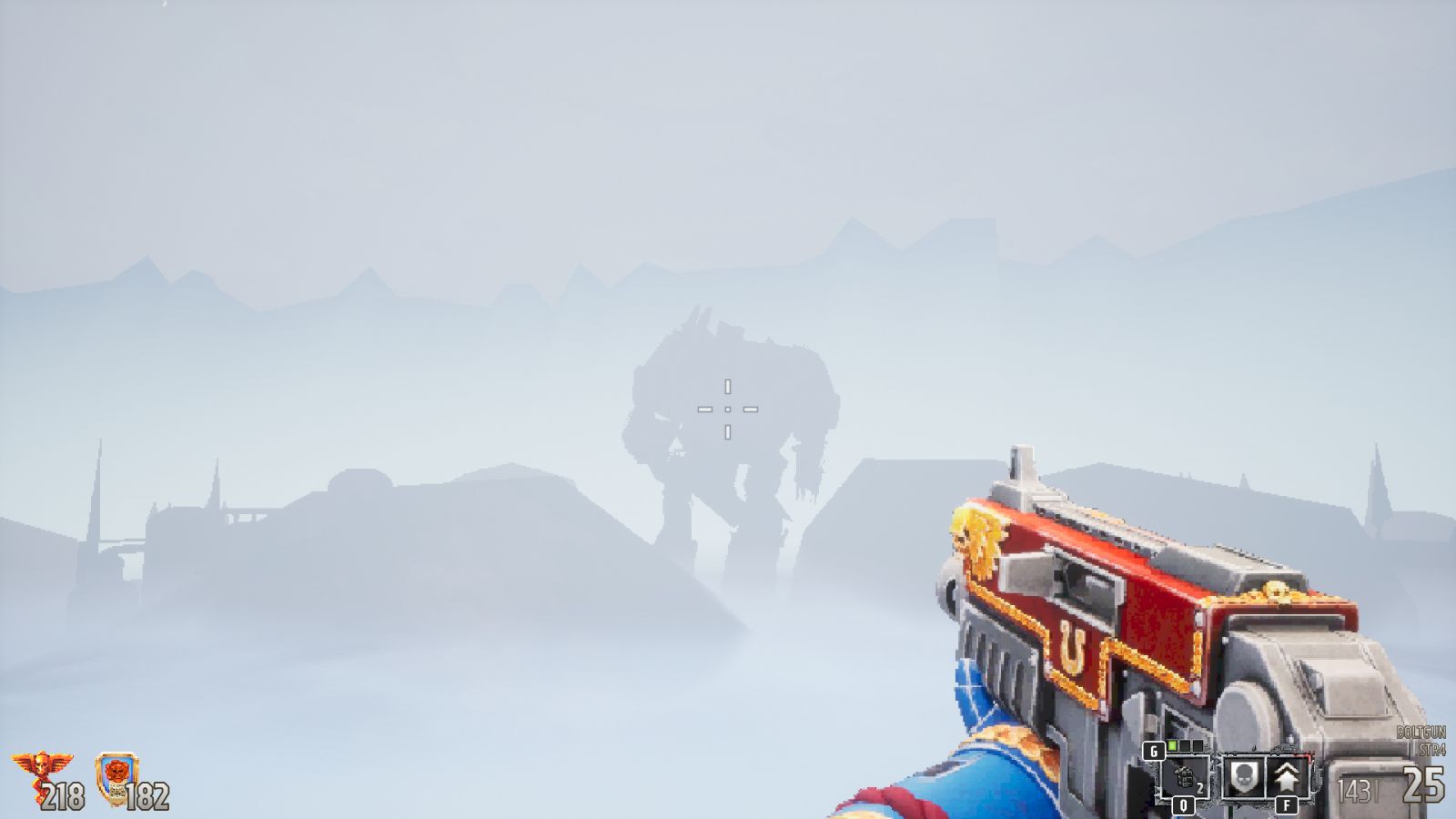
The combat in Boltgun is its strongest element. Both guns and melee feel punchy and sound satisfying. I’m glad this game did the boltgun justice. When you first come across the weapon, it’s being bathed in light at an altar; that’s a good sign. The gross overkill of firing a boltgun at a group of nurglings never gets old. In fact, there are quite a few enemies who die almost instantly to the power of the bolter. Of course, there’s more than just one gun. Your arsenal is a medley of 40K’s finest weaponry, like the meltagun, plasma gun, and vengeance launcher.
Each weapon has its own strength level, and each enemy has their own toughness level. Match or exceed the enemy’s toughness level with the correct gun for maximum damage. There’s no guesswork in it either, every gun has its strength level clearly stated, and you can see if your gun is effective against the enemy you’re facing by a symbol next to their health bar. When used correctly, all of the weapons feel impactful. However, it has to be mentioned that there is no weapon wheel, so you’re stuck either scrolling with your mouse – which is rather slow – or hitting the number keys, which can be imprecise in the heat of combat. Once or twice I accidentally wasted important ammo because I switched to the wrong gun. It didn’t happen often, but it was annoying, especially knowing there’s a better system out there.
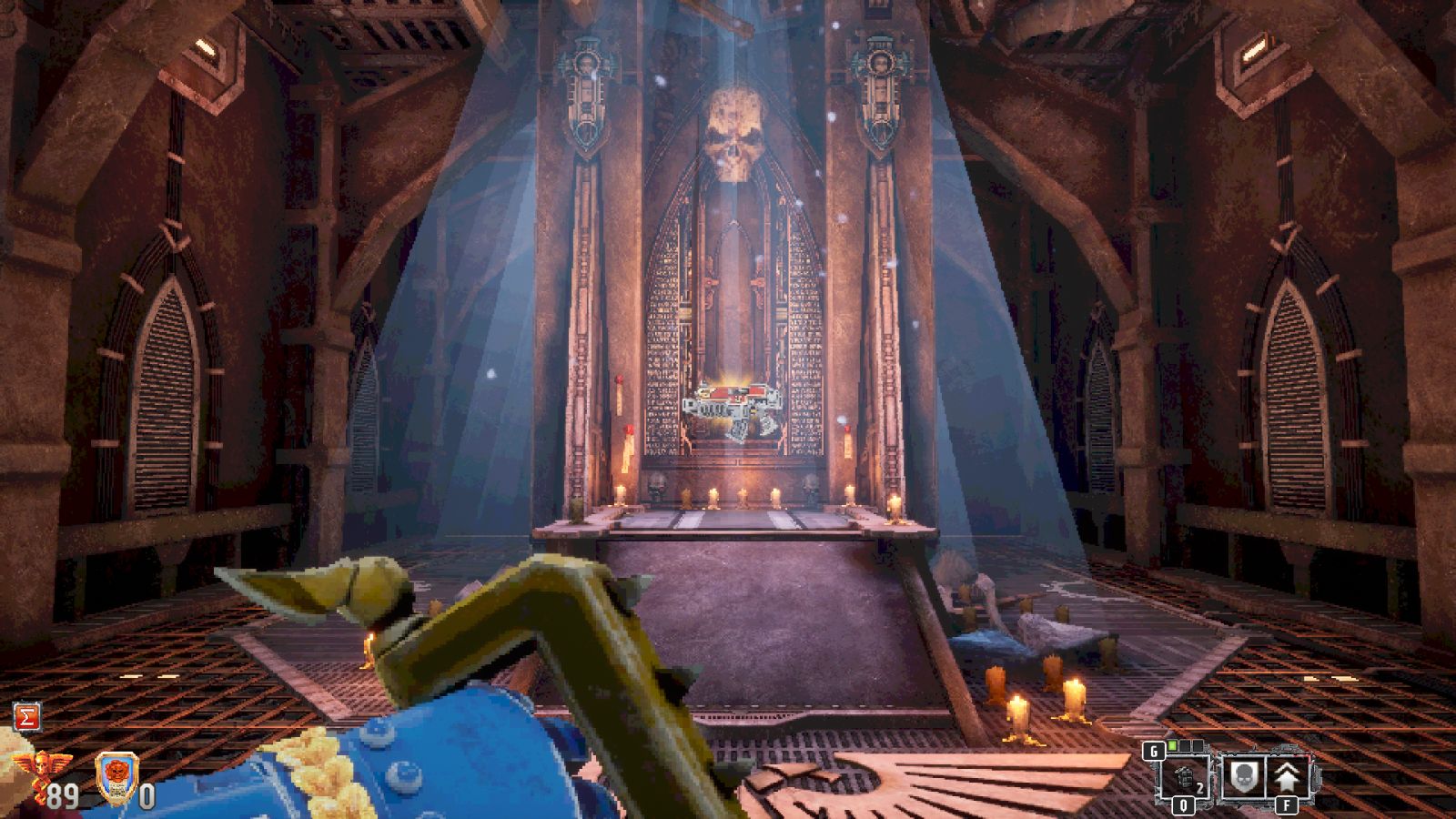
Guns aren’t your only means of combating the forces of the warp, you have your trusty chainsword with you at all times. Melee attacks slow time for a brief period before you lunge forward, adding a sense of explosive momentum to melee kills on smaller creatures. It captures how unnaturally fast and agile space marines really are. However, larger enemies can’t simply be cleaved to death instantly. The designers really thought about how to make the chainsword feel brutal. Once you’re attacking a larger enemy with it, you can spam the melee button to continuously cut them, shredding through them.
The range is quite decent on melee attacks, so you can use it to grapple to enemies above. If you’re the one with the high ground, then take advantage of the fact that you’re hundreds of pounds of armor and heretic hatred and fall right on top of them. Many enemies will just explode into viscera on the spot, splattering against the ground. The armor feels and sounds heavy while walking and jumping, so you really feel weighty when you move about, and like an unstoppable killing machine when you run.
The melee system, however, is also a missed opportunity. You gain health and contempt for killing enemies, contempt literally being your shield. However, I wish melee kills granted more contempt or health, scaling with the longer you were ripping into them with your chain sword. Why even take the risk of closing the distance when most large enemies will just immediately open fire on you? It mostly serves as a cool way to blitz across smaller enemies, finish off large enemies, or a grapple to gain elevation.
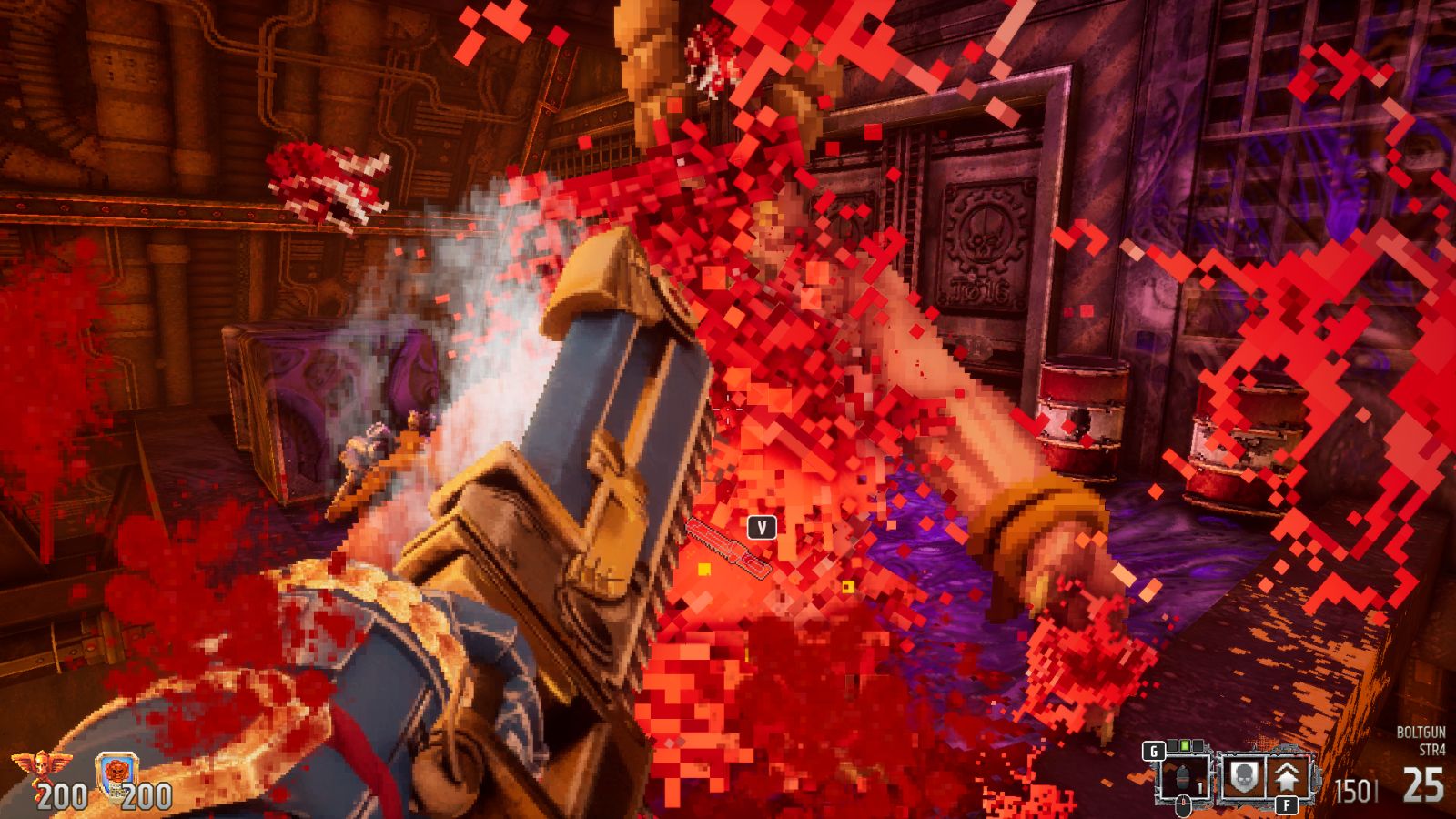
You also have a few abilities at your disposal. The first is a dash ability, which will propel you forward. Smaller enemies will die instantly if you come into contact with them during the dash. It really makes the player feel like they’re the massive force that is a space marine. Tackling a chaos space marine into a wall with my charge and putting him down with a round to the face was great. It felt like a clash between two titans, but it also wasn’t practical, and I could have saved myself a little health by just shooting him. The second ability is called “Know no Fear,” and it reflects projectiles and keeps you from dying for a short period while on low health. However, it’s incredibly confusing as to when it’s actually triggered, as the game never really explains it well.
On top of special abilities, there are also plenty of “secrets” which are basically power-ups that are incredibly easy to find, if not outright in your path. There are several types of secrets divided between relics and ammo which give you various combat advantages such as increased melee damage, increased armor, or infinite ammo for a time. If you play too passively, then you’ll find them after the fight, and have to awkwardly watch the countdown timer tick down as you use them on some low-level demon. It encourages players to move about the arena while they fight and be more aggressive in their tactics. There are also grenades, both timed and impact, and a special relic grenade that’s great for taking down bosses. It deals high damage over time with a massive AOE.
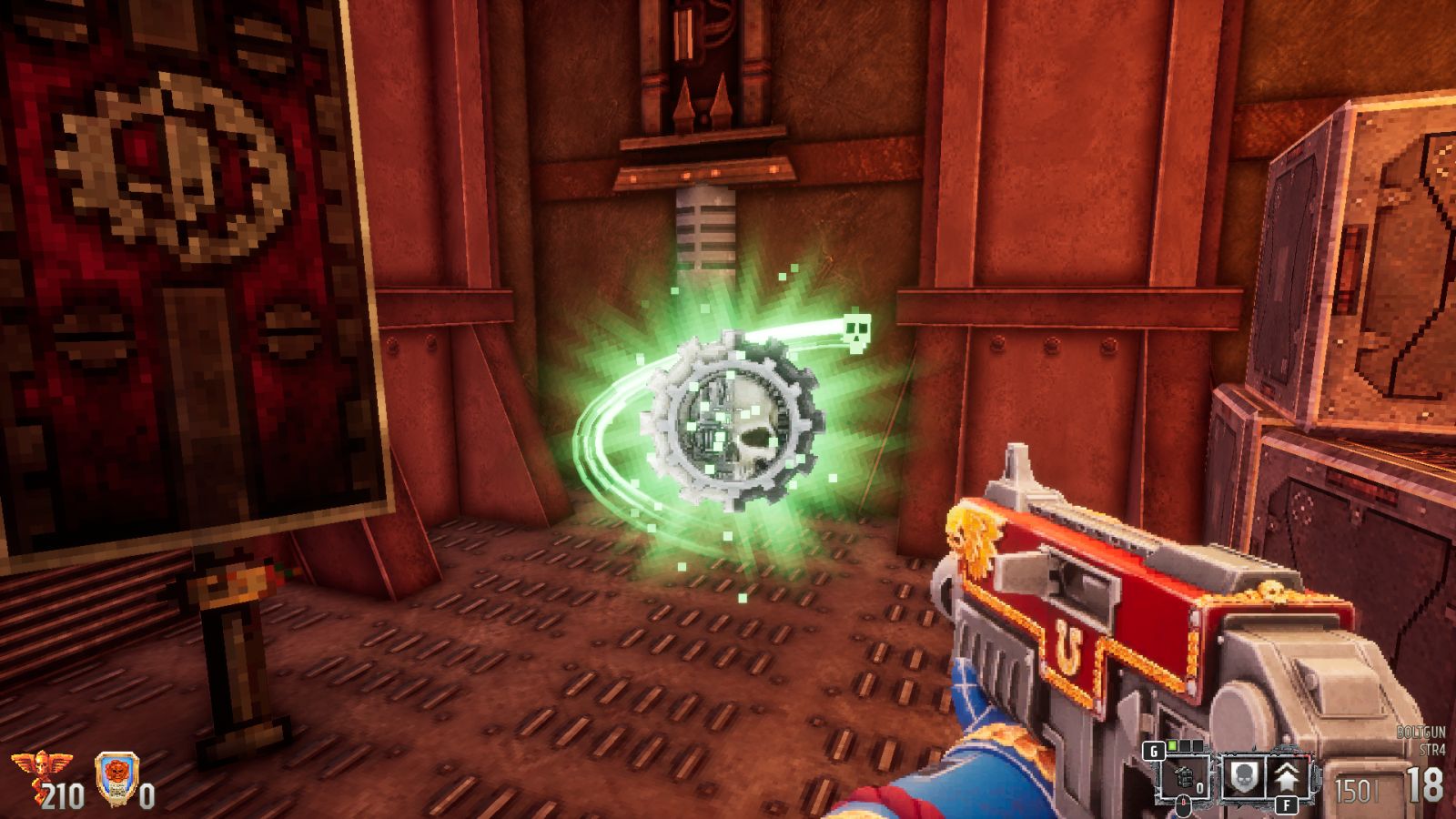
The enemies you face in Boltgun are almost as important as the weapons you use to slay them. Naturally, you’re fighting the forces of Chaos, which are portrayed incredibly well. Chaos enemies are unpredictable, spawning more enemies upon death or transforming into something else. The aspiring champion will reincarnate if killed, meaning you have to destroy their remains before they have a chance to get back up. I wish there were more depth like this in the game, but that’s about as far as it goes.
There are three chapters, with eight levels per chapter. The levels are all pretty distinct from each other. In one location you’ll be fighting off enemies on a big moving magrail, in another you’ll be in the forges, outracing rising lava. It’s good that they picked a forge world as the setting, as it showcases the massive scale that the 40K franchise is known for. On the first level, you can see the sun’s radiance spiral out in contrast with the dark silhouettes of churches and artillery batteries in the distance. In other places, you’ll be launching yourself from platform to platform in a massive cathedral. You bet that the windows are stained glass! Yep, that’s 40K!

Many levels have a similar problem, one that represents Boltgun’s problems as a whole, poor communication. A lot of these levels are sprawling, maze-like, and loop around. I’m not really a fan of big pointers on compasses, but Boltgun really would have benefited from a map. Even a little bit more level design to show where to go would be nice. I know they’re capable of it, they do it sometimes, but they just don’t do it consistently enough.
At one point, you have to go in and out of the same door three times, with it taking you to a new place each time. It’s implying that you’ve moved to a new floor because you’re on a giant elevator platform, but it’s easy to miss the animations because the elevator is moving during combat. Your skull companion has an easy-to-miss, confusing text prompt about checking the floor, but you’re on a massive platform with multiple levels of verticality, so it would have just made more sense to tell you to go through the door.
At another point in the game, I came across giant, stationary, slowly rotating gears that will instantly kill you if you dare to graze them. I never saw any indication that they were that dangerous, no hazard signs, nothing. A lot of these problems could have been solved by being able to manually prompt the servo skull to give you directions, giving it a real purpose in the game.

Another odd choice is that you lose all of your weapons except for the boltgun between chapters. You have to find them again throughout the levels of the chapter, but why? It just shoots the gameplay in the foot for no reason. The gunplay is the best part of Boltgun. Why take it away?
Occasionally during your adventure, bosses pop up. It’s important to note that some of the bosses are rather underwhelming. They lack variety, as you’ll be fighting the same four bosses over and over again. I had to fight one boss, the Lord of Change, six times in total. I didn’t even like fighting him the first time, he’s not particularly difficult or anything; he’s just annoying. He has a habit of teleporting away during the fight, and adding to the communication problem, he has a poorly telegraphed attack that hurts you for being in his line of sight. His hands just turn purple, and you start taking damage. That compounds with poor audio and visual cues for being damaged, meaning it’s not uncommon to look down and see your health is gone. All you’re given are a few grunts and some blood on the screen when you’re already low on health. I’ve even had enemies spawn right next to me on occasion with little to no audio cues. Boltgun really could benefit from better telegraphing.
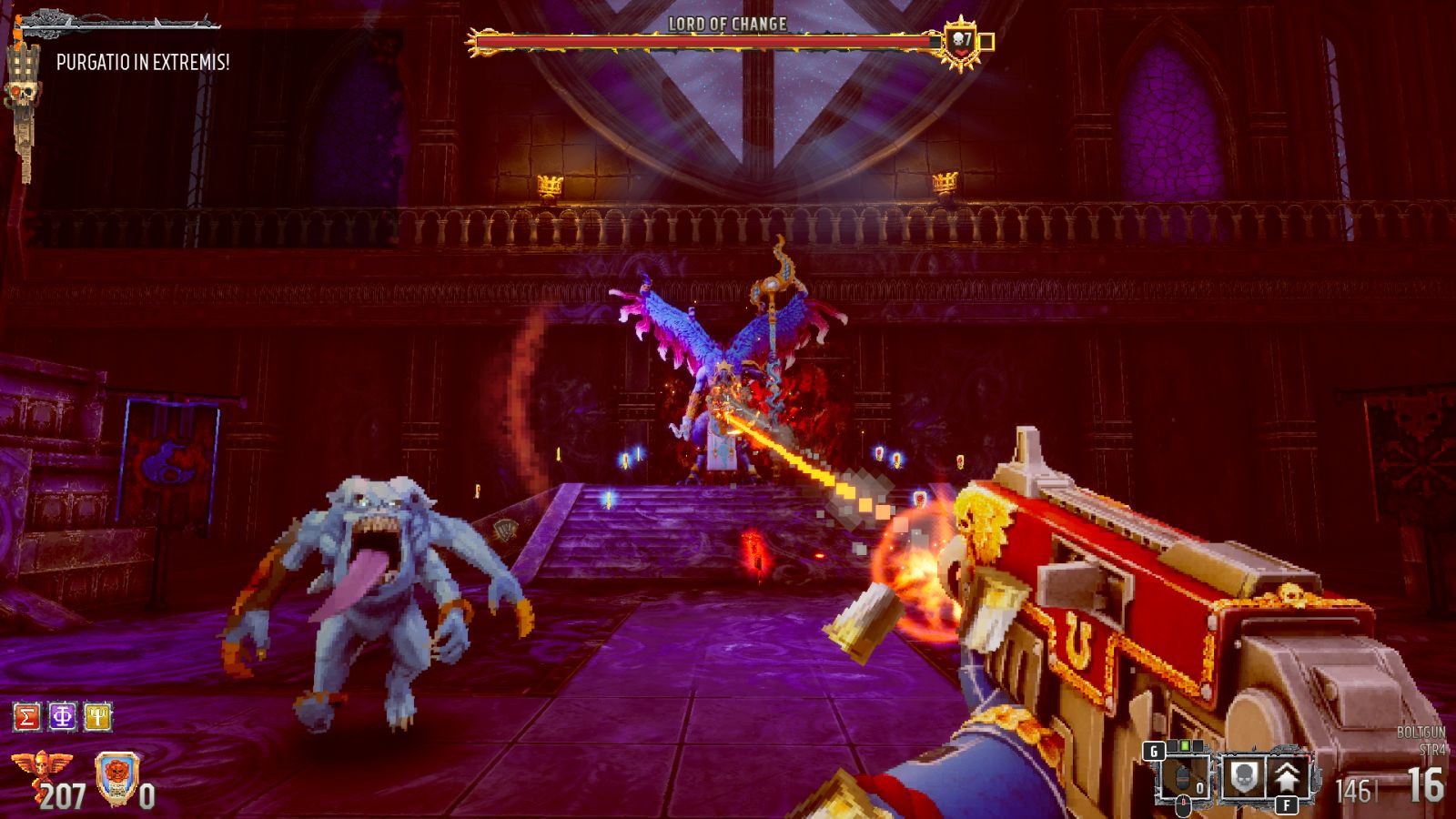
This paragraph talks about the final boss. I don’t talk about the ending or who the final boss is, but I do talk about the gameplay elements, so skip to the next paragraph to prevent fight spoilers if it’s important to you. The final boss is tedious, he’s just an amped-up version of the sorcerer boss, and you have to kill him three times because the fight is also a diet boss gauntlet of the same bosses you’ve already fought multiple times. The cherry on top is that he shields himself, and the shield is connected to the other bosses who you have to kill before you can damage him. It didn’t feel like a test of my abilities; it felt like a test of my patience.
While they fumbled on the bosses, they just get the 40K aesthetic. For example, your idle animation is reading the Codex Astartes, the spammable taunts are all devout and fanatical, and the hardest difficulty is called “exterminatus.” There’s even a massive memorial to over 200 civilians who died building an elevator so that people could ascend the floors a little bit faster. It understands the universe in a way that makes it pretty clear that the developers did their homework.
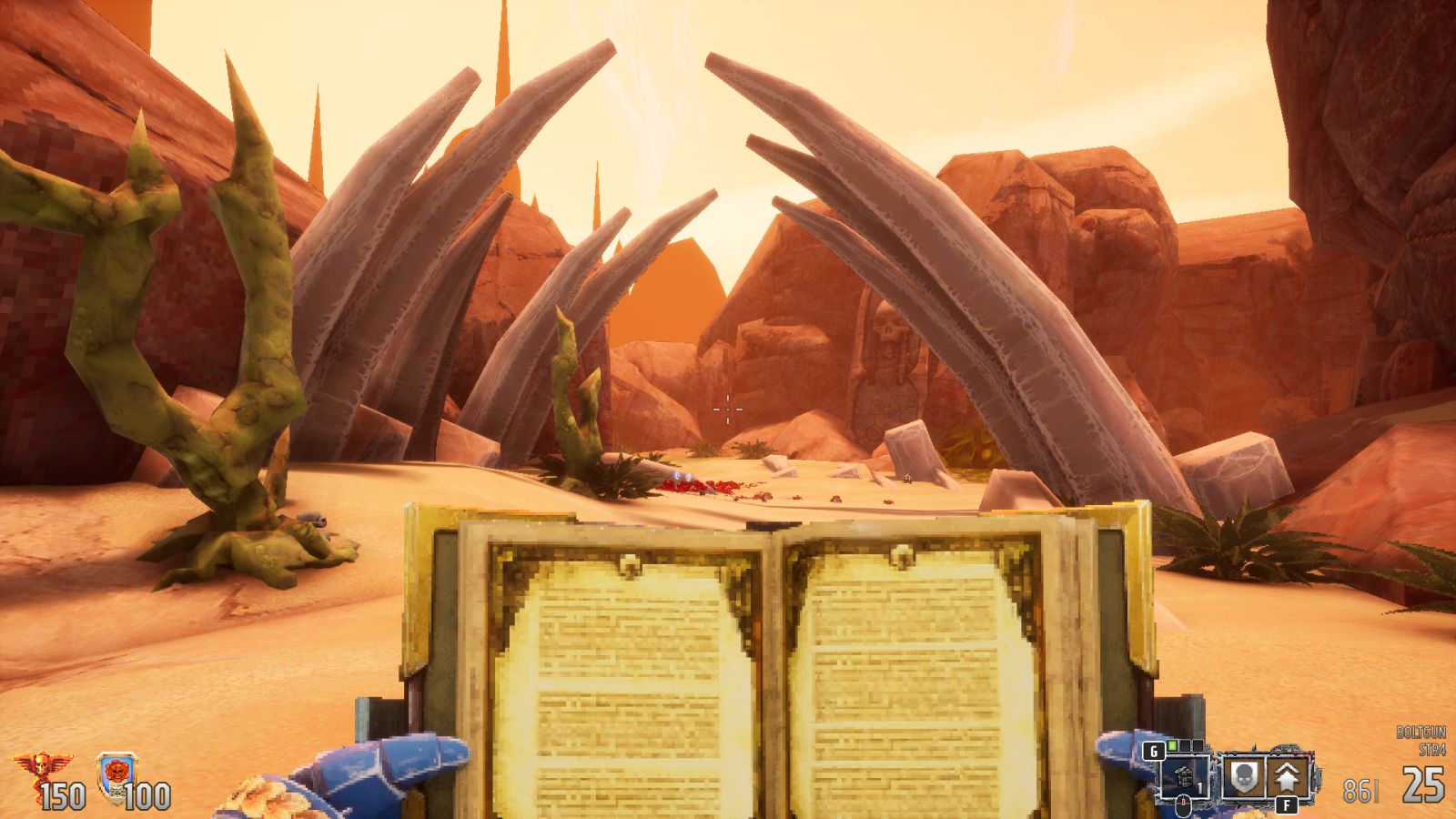
The graphics of the game are adjustable. You can change the pixelation and retro palette in the settings. I would recommend turning the retro palette to 0 and the pixelation to 100 for the sharpest visuals. You could also do the inverse if playing on exterminatus just isn’t difficult enough for you.
Of course, while talking about the art it’s essential to talk about the soundtrack. When I first heard the lobby music, it reminded me of Risk of Rain 2, which seemed like a good sign. However, the soundtrack was largely forgettable. Not a single track stuck out to me, and they all sort of blend together. They’re not bad by any means, but they don’t stand out either.
Overall, Boltgun has a treat of a core gameplay loop, with an over-the-top setting to back it up, but don’t expect it to do anything fancy or groundbreaking. Warhammer 40k might be a universe of entropy, but the potential of the franchise is burning brighter than ever. If Boltgun interests you, then you can buy it for $21.99.
Warhammer 40000: Boltgun
Good
Warhammer 40,000: Boltgun is an excellent retro shooter that, to both its benefit and detriment, doesn't take risks. The repetitive bosses and poor communication to the player might turn some people away. However, Its tight core gameplay loop is gory and punchy, and it captures the essence of what it feels like to be a space marine in both movement and power.
Pros
- Excellent core gameplay loop
- They understand the 40K aesthetic
- Diverse levels
Cons
- Poor communication of key information
- Repetitive bosses
